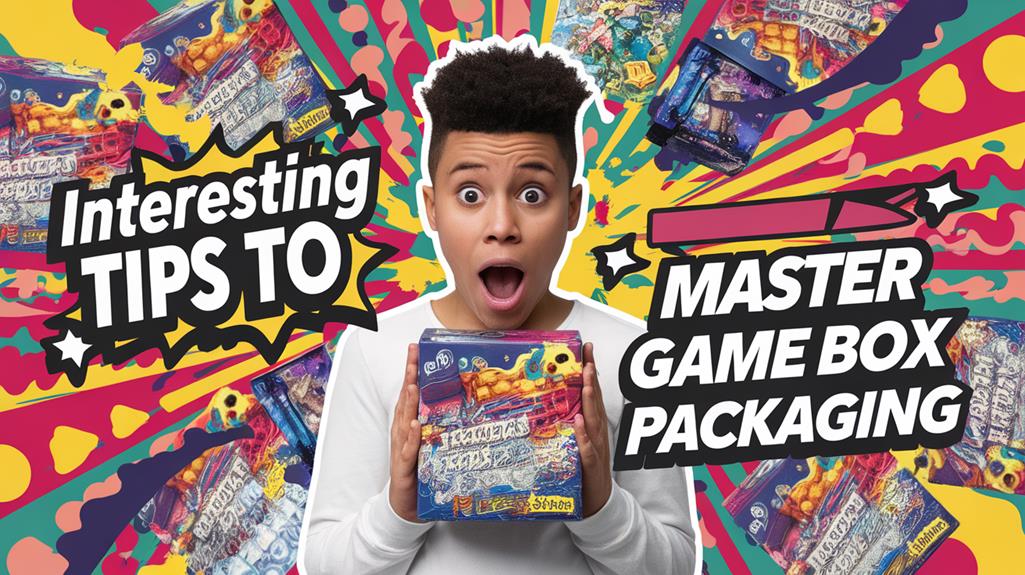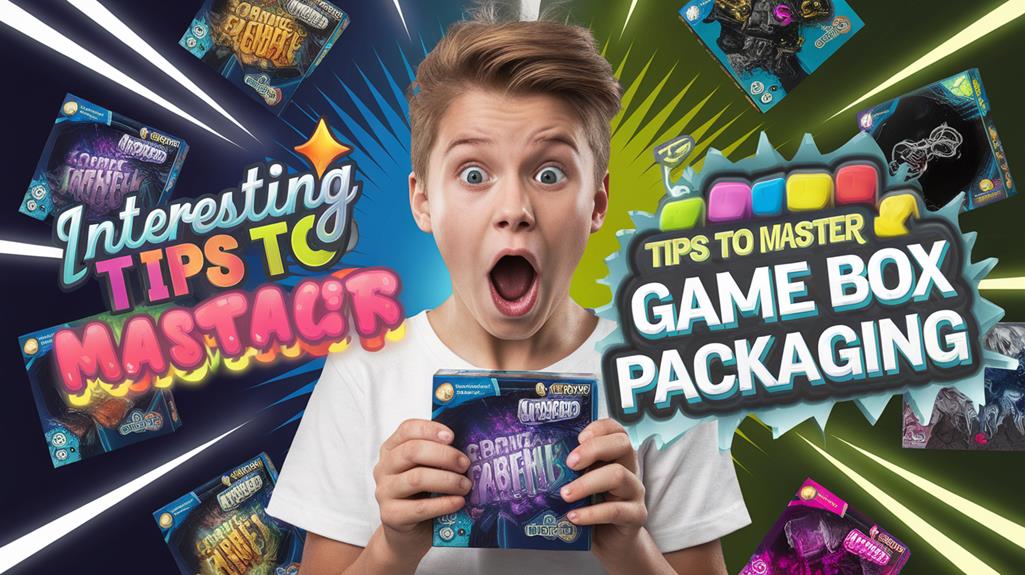8 Interesting Tips to Master Game Box Packaging
2025-08-04 15:28:29.jpg)
Mastering game box packaging can transform your product's appeal. Start by choosing durable and eco-friendly materials; your customers will appreciate your sustainable choices. Make sure your box size fits snugly around the game components, preventing any damage during transit. Stunning box art engages players and communicates your game's essence effectively. Incorporate custom inserts to organize pieces and enhance the unboxing experience. Don't forget about tactile elements like soft-touch coatings for added luxury. Finally, stay aware of packaging trends to keep your design fresh and appealing. There's so much more to discover that can elevate your game packaging strategy!
Main Points
- Utilize durable, eco-friendly materials to enhance brand image and appeal to environmentally conscious consumers.
- Incorporate custom inserts to securely hold game components, improving organization and user experience.
- Design eye-catching box art with high-contrast colors and clear information to attract your target audience.
- Consider unique finishes, such as UV stamping, to create memorable unboxing experiences that delight consumers.
- Research current trends, like minimalist aesthetics and interactive features, to ensure your packaging remains relevant and appealing.
Importance of Game Box Packaging
When you think about game box packaging, imagine it as the first handshake between your game and potential players. This initial interaction shapes consumer perception, influencing their decisions before they even pick up the box. A well-designed package not only communicates your brand identity but also reflects the quality within, creating increased brand exposure and recognition.
It's a visual invitation that can't be ignored. Effective packaging enhances the unboxing experience, heightening excitement and satisfaction. Think about how a beautifully crafted box can elevate anticipation as players peel back layers to discover what's inside.
It's essential to use durable materials like cardboard or rigid boxes to protect game components during shipping and storage, ensuring everything arrives in pristine condition. Eye-catching graphics and clear labeling—showcasing player counts and age ranges—are important for grabbing attention and securing proper shelf placement.
Plus, embracing sustainable practices by using recycled materials can resonate with environmentally conscious consumers, aligning your product with the growing trend toward eco-friendly offerings in the gaming industry.
Ultimately, your game box packaging serves as a powerful marketing tool, adding value and enhancing the overall gaming experience.
Tailoring Packaging to Game Types

Tailoring packaging to different game types is essential for capturing players' attention and enhancing their experience from the moment they encounter your product.
Start with game type considerations; for instance, lightweight paperboard works wonders for card games, while games with numerous components need premium rigid boxes to guarantee component protection and visual appeal. Incorporating unique branding elements can further elevate the packaging's appeal.
Make certain your box size perfectly accommodates all game pieces. A snug fit avoids discrepancies that can lead to improper shelf placement and increased shipping costs. Incorporating custom inserts is a smart move, especially for games with various components. These inserts secure pieces in place, enhancing durability and user experience.
Don't underestimate the power of eye-catching designs! Use vibrant graphics and informative elements, including player count and age recommendations, to attract your target audience and allow for quick understanding of the game.
Consider eco-friendly packaging solutions, like biodegradable materials or recycled cardboard. This not only appeals to environmentally conscious consumers but also aligns with modern sustainability trends.
Choosing Materials and Structure
Creating an engaging game box starts with the right choice of materials and structure, which can greatly impact both durability and appeal. Opt for sturdy materials like 1mm-2mm thick cardboard, guaranteeing your box withstands wear and tear during transit and repeated use.
This choice not only fortifies the box but also enhances packaging aesthetics, making it more visually appealing on shelves. Incorporating sustainable packaging practices can also resonate with consumers, as 82% are willing to pay more for eco-friendly options.
Consider eco-friendly options, such as recycled cardboard, to attract environmentally conscious consumers. It's a win-win—customers appreciate sustainability and you boost your brand's image.
Custom inserts made from foam or cardboard are another smart move. They secure game components, preventing movement during shipping and enhancing the overall experience for players.
Don't forget to research common box sizes and styles of similar themed games. This guarantees your packaging is appropriately sized for retail display, ultimately minimizing shipping costs.
Protective Packaging for Safe Game Delivery
Ensuring your game arrives in perfect condition starts with selecting durable, well-sized boxes that fit your product snugly. This prevents internal shifting and minimizes the risk of damage during transit. Adding cushioning materials such as bubble wrap or packing peanuts further safeguards delicate components by absorbing impact. For enhanced protection, consider using shrink wrap or plastic bags to guard against moisture and water damage, helping your shipment remain intact throughout its journey.
Boosting Brand Value and Shipping Efficiency
Incorporating custom printed boxes not only enhances the unboxing experience but also strengthens brand visibility and communicates quality to customers. Clear labeling with handling instructions and fragile warnings signals shipping personnel to treat packages with care, reducing the chances of mishandling. Avoid overpacking and leave small gaps at the corners for cushioning—this smart packaging technique absorbs shock more effectively. These best practices ensure a secure, professional shipping process that reinforces your brand’s reliability.
Eco-Friendly Packaging Options

While ensuring your game arrives safely is vital, it's equally important to reflect on how your packaging impacts the planet. By embracing eco-friendly packaging options, you not only cater to environmentally conscious consumers but also contribute to sustainable practices.
Sustainable packaging reduces environmental impact and aligns with eco-friendly practices, making it an essential factor for modern businesses. Here are three innovative approaches to evaluate:
Biodegradable Materials: Use plant-based plastics and recycled cardboard for your packaging. These materials break down naturally, reducing your environmental footprint.
Minimalistic Design: Adopt a streamlined packaging design that minimizes ink usage and eliminates excess materials. This approach not only saves resources but also enhances visual appeal.
Eco-Friendly Printing: Opt for water-based or soy-based inks instead of traditional petroleum-based inks. These options are less harmful to the environment and promote sustainability.
Partner with suppliers who prioritize eco-friendly practices. Highlighting these partnerships in your marketing materials reinforces your commitment to sustainability.
Don't forget to encourage your customers to recycle or reuse the packaging by including clear recycling instructions on the box. By making these conscious choices, you'll not only protect the planet but also attract a loyal customer base that values sustainable packaging innovations.
Engaging Box Art Design
With the right box art design, your game can leap off the shelves and into the hearts of players. Start by harnessing the power of visual storytelling. Use thematic visuals that capture the essence of your game, drawing players in at first glance.
Incorporate high-contrast colors and bold typography to guarantee your design stands out, whether in stores or online. Don't underestimate the role of color psychology; certain hues can evoke specific emotions and responses. For instance, vibrant reds can create excitement, while calming blues may suggest strategy.
Make certain essential information—like player count, age range, and game mechanics—are clearly displayed on the front, allowing potential buyers to quickly grasp what your game offers. Consider adding unique shapes or finishes, such as spot UV or foil stamping, to enhance the tactile experience.
This not only grabs attention but also creates a memorable unboxing moment that players will cherish. Finally, analyze successful games similar to yours for design inspiration. Look closely at color palettes and imagery that resonate with your target audience, and let those insights guide your own box art creation.
Attracting Your Target Audience
Attracting your target audience starts with a deep understanding of who they're and what they love. By diving into audience preferences, you can tailor your game box packaging to resonate deeply with potential players.
Here are three strategies to enhance your approach:
Research Demographics: Investigate popular themes and mechanics in successful games. This insight allows you to align your box design with the interests of your target audience, ensuring it captures their attention.
Utilize Visuals and Language: Incorporate specific terminology and visuals that speak directly to your intended audience. For example, if you're targeting hardcore role-playing enthusiasts, fantasy elements can greatly boost your appeal.
Analyze Competitors: Look at the packaging strategies employed by successful games in your genre. Identify design choices that captivate similar audiences, and innovate upon them to make your packaging stand out while staying true to packaging psychology.
Trends in Game Packaging Design
As the gaming industry evolves, staying ahead of trends in game packaging design is essential for capturing players' attention.
Today, minimalist aesthetics are more than just a design choice; they reflect a commitment to sustainability that resonates with environmentally conscious consumers. Reducing waste not only helps the planet but also aligns your brand with the values of your audience.
The rise of mailer boxes is another trend worth noting. Their compact design makes them perfect for travel-friendly games, enhancing convenience for both retailers and players.
You can also elevate your packaging's visual appeal with eye-catching finishes like foil stamping and soft-touch coatings, creating a tactile experience that draws customers in.
Don't overlook the importance of custom inserts; they secure game components while improving organization, resulting in a smoother unboxing experience.
Consider integrating augmented reality features. This innovation allows players to interact with the game right from the packaging, providing a unique marketing opportunity that can set you apart from the competition.
Conclusion
Mastering game box packaging isn't just about protection; it's your chance to captivate and engage players. By tailoring your design to your game's essence and choosing sustainable materials, you not only enhance the unboxing experience but also resonate with eco-conscious consumers. Remember, eye-catching art and clever branding can set you apart in a crowded market. So, get creative, stay informed on trends, and watch your game thrive as it stands out on the shelves!
